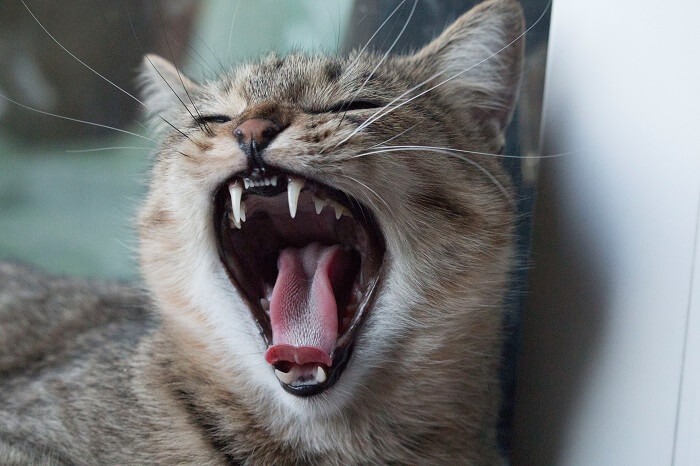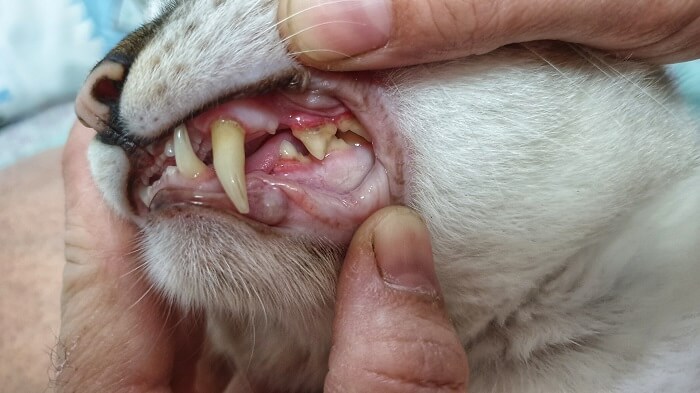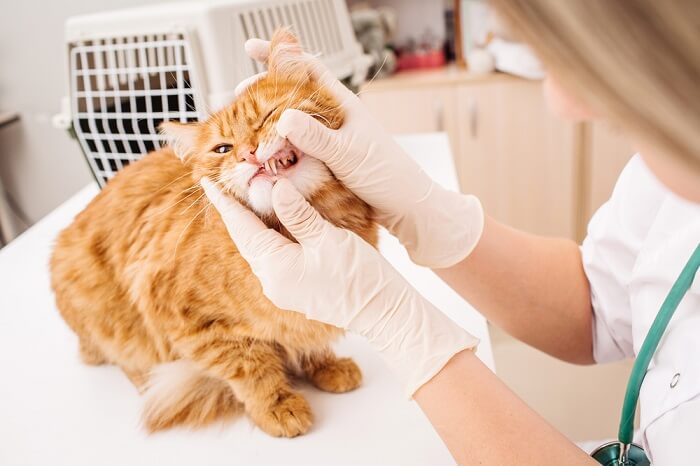
A cavity (in cats, known as tooth resorption) is a painful condition in which one or more teeth are broken down and reabsorbed by the body. It’s very common, with 20-60% of all cats developing the condition in their lifetime.
Today, we’ll discuss what causes feline cavities, what to look for, and why it’s so important to treat this condition.
Quick Overview: Cavities in Cats







What Are Cavities in Cats?
Cats don’t get cavities—at least, not the same kind of cavities that humans get from eating too much sugar. While human cavities are caused by bacteria and tooth decay, in cat cavities the affected teeth erode for reasons not entirely understood.
This problem in cats is called a FORL (feline odontoclastic resorptive lesion) or feline tooth resorption.
While it’s technically not the same thing as a cavity, sometimes the terms are used interchangeably, for simplicity’s sake. Additional names include feline caries or cervical/neck lesions.
Tooth resorption means that one or more affected teeth start to break down. On dental x-rays, they appear to be eroding or disintegrating. Lesions may affect the root (the part of the tooth below the gumline), the crown (the part of the tooth above the gumline), or both.
Any tooth may be affected, but the molars and premolars (cheek teeth) are most commonly affected, especially the premolars of the mandible (lower jaw).
There Are Two Types of Forls, Each With Different Treatments
Feline cavities or resorptive lesions are grouped into two categories: Type 1 and Type 2.
- With Type 1 lesions, the tooth is being resorbed, but the tooth root is still distinguishable from the surrounding jaw bone.
- Type 2 lesions, on the other hand, mean the resorbed areas are replaced by bone. So, it’s difficult or impossible to differentiate the tooth root from the jaw bone.
This distinction is important because the type of FORL will determine the type of treatment that is needed.
What Do Cat Cavities Look Like?

Cavities in cats are painful, but their instinct is to hide pain, so sadly many kitties suffer in silence.
It may be challenging to examine a cat’s mouth at home, especially if they have a painful tooth. Also, visible changes to the tooth are often subtle, especially in the early stages.
For these reasons, many pet parents are clued into the presence of a FORL or cavity because of their cat’s behavior, rather than by visualizing the lesion itself.
Common symptoms of feline tooth resorption include:
- Changes in eating habits, such as:
- Decreased appetite.
- Dropping food.
- Swallowing food whole rather than chewing it.
- Chewing on just one side of the mouth.
- A sudden desire for canned/soft food or avoidance of kibbles/dry food.
- Jaw “chattering.” This is when the lower jaw trembles, especially when the painful part of the mouth is touched.
- Drooling.
- Pawing at the mouth.
- Bad breath (halitosis).
- Weight loss, if ability to eat is impacted.
- Redness, bleeding, or swelling anywhere along the gumline.
- Missing teeth.
- A strip of red-pink tissue growing over the tooth’s crown—the body’s way of covering up a defect from tooth resorption.
- Behavior changes such as lethargy, grumpiness, or hiding more often.
Some of these symptoms may indicate other dental problems or health issues, rather than tooth resorption. Either way, it’s important to schedule a vet visit.
Important: Many cats show NO symptoms! Sadly, because of their instinct to hide pain, many kitties suffer in silence. That’s one of the reasons why regular checkups and dental care are so important.
Do Cavities Hurt Cats?
Yes, tooth resorption can be very painful, although it may depend on which part of the tooth is affected.
Lesions affecting just the root may or may not cause significant discomfort. However, if a lesion erodes the crown (above the gumline), the tooth becomes extremely sensitive and very painful.
What Causes Cavities in Cats?
The causes of resorptive lesions are not well understood. Some theories (including nutritional/dietary factors) have been explored, but none have been definitively proven.
One thing that may be within a pet parent’s control is their cat’s routine dental care. Unfortunately, having a healthy mouth won’t prevent FORLs in cats who are prone to them. However, since significant oral/dental disease has been associated with FORLs due to inflammation, it’s a good idea to be proactive about your kitty’s oral health.
How Are Cavities in Cats Treated?

Treatment of cavities always include dental procedures, and the specific protocol depends on which type of FORL is present (x-rays and radiographs are used to determine this).
Treatment always involves a dental procedure (full evaluation, cleaning, and treatment for any issues such as tooth resorption under general anesthesia) at a veterinary practice. However, the specific protocol depends on which type of FORL is present.
Dental x-rays are performed on the day of the procedure, to determine which type of FORL is present. Radiographs may also uncover tooth resorption in cats who have no symptoms.
- For Type 1 lesions, the whole tooth must be extracted (removed). This is because any part of the tooth left behind may continue resorbing, resulting in inflammation or pain.
- For Type 2 lesions, a crown amputation (removing the crown of the tooth while leaving the root in place) is preferred. Fortunately, with this type of lesion, the root isn’t painful once it’s integrated into the jaw bone. The crown of the tooth can still be painful, so removing the crown eliminates discomfort while avoiding unnecessary root extraction.
Conclusion
Feline tooth resorption, often referred to as cavities, is a painful condition that affects a lot of cats. Fortunately, routine dental care can help detect and treat these lesions early, for improved quality of life and overall health.
Frequently Asked Questions
Can cats get cavities?
Cats don’t get the same type of cavities that humans do. However, cats commonly develop a condition in which the tooth (or teeth) resorb or ‘erode’. This is known as feline tooth resorption, although sometimes it’s referred to as a cavity.
What are the symptoms of dental problems in cats?
Common symptoms include bad breath, redness or bleeding of the gums (gingivitis), behavior changes (hiding or being grumpy), or changes to eating habits such as dropping food or eating less. Some kitties might not show any symptoms, even if their teeth are painful, so it’s important to get regular wellness checks and discuss dental care with your veterinarian.
How to prevent cat cavities?
Unfortunately, tooth resorption not preventable. However, regular dental care with your veterinarian (and home care such as brushing your cat’s teeth) can help to prevent a lot of other dental problems, including periodontal disease that could otherwise lead to pain, tooth loss, and even heart or kidney problems.
How to treat cat dental problems?
A dental health plan consists of home care and veterinary care. At home, you can learn how to brush your cat’s teeth—ask your vet team for help/instructions, and be sure to use a pet-safe toothpaste and toothbrush. Dental food and treats may also help.
The gold standard of care is a dental evaluation and cleaning with your veterinarian. Your vet will let you know how often this procedure is recommended as part of your pet’s preventive health plan. Be sure to call your vet if you notice any dental symptoms between visits, too.







